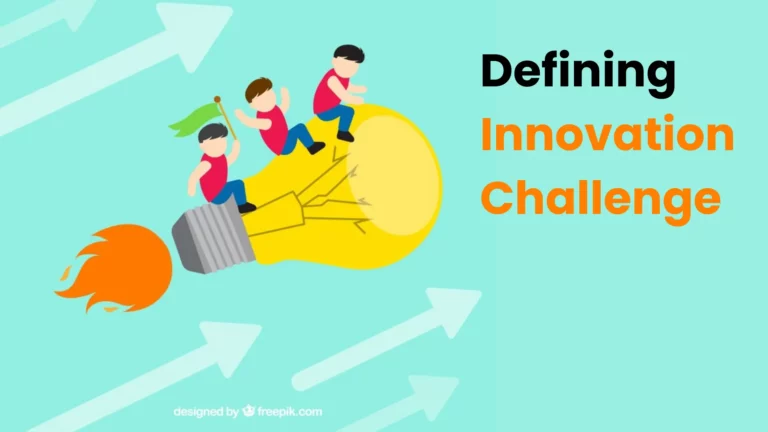Let’s get you started immediately with understanding how to define innovation challenge and putting the innovation challenge template to use.
Downloadable Innovation Challenge Template
#1 Select a Medium to Launch the Innovation Challenge
The choice of medium significantly impacts the success and effectiveness of your innovation challenge.
Select the right medium to add the challenge topic in detail and provide access to either specific or multiple segments of the organization, including teams working from across global bases.
Examples of medium include:
- Automated idea and innovation management system
- Online on the company website
- Email newsletters
- Organize or sponsor hackathons for crowdsourcing
We recommend using a professional and dedicated cloud-based system for focused innovation challenges. Simply because they:
- Enable global participation.
- Provide user-friendly interfaces and tools for collaboration.
- Yield diverse and more high-quality submissions tailored to your challenge’s needs.
- Streamline the capturing, evaluating, and implementing process, making it quicker to launch, manage, and conclude the challenge.
- Track participation metrics, gather feedback, and analyze the impact of the challenge.
#2 Identify the Challenge For Which You Need Innovative Ideas and Solutions
Since the problem statement is the foundation of your entire challenge, make sure you pick the right one. A complex problem may be too much for the first innovation challenge and may lead to a low participation rate.
Too simple may defeat the purpose of engaging everyone.
Link the problem to current organizational priorities. If improving operational efficiency is a priority, an innovation challenge aimed at streamlining processes will be relevant.
#3 Describe the Challenge In Detail
Detailed descriptions help participants fully understand the challenge’s objectives and what is expected of them.
When participants understand the significance of the challenge and its potential impact, they are more likely to be engaged and committed.
- Give a crisp title to your innovation challenge.
- Add details, the objective, why this challenge matters, and why their efforts are necessary.
- Attach supporting information, such as references, multimedia, links, and so on.
- Pick whether you want the entire workforce to participate or specific business unit(s).
#4 Mention Available Resources to the Participants
Mention what resources they have at their exposure to develop ideas, and solutions, and take their invention to the next level. For example:
- Prior art search availability.
- Access to market insight reports.
- Access to customer feedback reports.
- Training sessions.
- Latest trends and patterns report.
- Other qualitative and quantitative data.
- Live communication with multiple stakeholders, including top management, evaluators, co-innovators, and so on.
#5 Provide a Participation Timeline
Establishing a clear and detailed timeline for an innovation challenge is crucial for maintaining structure, ensuring participant engagement, and achieving desired outcomes.
Here is a breakdown of each phase:
a. Launch Date:
Preparations Leading to the Launch:
- Announcement and Promotion
- Activities on Launch Date
- Official Launch
- Resource Distribution
b. Submission Deadline
During the Submission Period:
- Ongoing Training and Support
- Mid-Point Check-In
- Encourage Collaboration
c. Final Week Push
- Reminders and Encouragement
- Submission Logistics:
d. Evaluation Period
- Initial Screening
- Eligibility Check
- Preliminary Review
- Detailed Evaluation
- Judging Panels
- Evaluation Criteria
- Scoring and Feedback
e. Final Deliberation
- Shortlisting
- Final Implementation
f. Winners Announced
g. Post-Announcement Activities
- Feedback to Participants
- Follow-Up Communication
#6 Disclose the Evaluation Criteria
Learning how to define innovation challenge is incomplete without setting the evaluation criteria.
For instance, the following can be your evaluation parameters:
- Innovation and Creativity: Assess the originality and creativity of solutions, looking for novel approaches and unique features that break new ground.
- Feasibility and Practicality: Practicality and feasibility within organizational constraints, including resource availability and technical viability.
- Potential Impact on Customer Experience: Do solutions address customer needs, improve satisfaction, and contribute to loyalty and retention?
- Alignment with Company Goals: Alignment with the organization’s strategic objectives, ensuring consistency with mission, values, and long-term goals.
#7 Curtain Down on the Ongoing Challenge
As we near the conclusion of the challenge, the final deliberation stage begins. Here, evaluators meticulously analyze each submission, assessing its level of innovation, feasibility, potential impact, and alignment with the company’s goals.
Following a period of evaluation, the winners are officially announced, and their innovative solutions are recognized and implemented.
However, your commitment to fostering innovation must not end there. Post-announcement, participants must receive comprehensive feedback on their submissions, providing valuable insights for future endeavors.
Get Started Immediately, Free of Cost
Run your first innovation challenge and see increased innovation impact within the challenge timeline. Start here: Innovation Challenge Template Online
How to define innovation challenge and launch it?
Downloadable Innovation Challenge Template



